
Una solución informática basada en PM² para el sector público europeo
¿Cómo es una solución de software que permite a los empleados del sector público priorizar, gestionar, implementar y reportar con éxito iniciativas estratégicas?
En OpenProject, exploramos esta cuestión durante un hackatón la semana pasada. En este artículo le ofrecemos un resumen de nuestros resultados.
Los requisitos que definimos se basan en PM², la metodología de gestión de proyectos de código abierto facilitada por la Comisión Europea.
Vea este vídeo para hacerse una idea de OpenProject para la gestión de proyectos y carteras del sector público:
Este vídeo está actualmente disponible solo en inglés.
Navegación por el artículo:
- Se busca: una solución informática para la aplicación estratégica de iniciativas federales de digitalización
- Entregado: compromiso total para diez nuevas funciones e implementación en PM²
- ¿Ya lo encontró? ¿Qué ocurre después del hackatón?
Se busca: una solución informática para la aplicación estratégica de iniciativas federales de digitalización
La transparencia es uno de nuestros valores fundamentales, por lo que en este artículo queremos compartir un resumen del hackatón, los requisitos y, por supuesto, nuestras soluciones propuestas.
Requisitos incluidos:
- Compatibilidad con PM² (adaptación)
- Coherencia entre los niveles de cartera, programa y proyecto
- Colaboración entre agencias
- Agilidad
- Experiencia de usuario agradable
Desafíos para nosotros:
- Solo una semana para desarrollar funciones adicionales, material de demostración completo, documentación y presentación (en vídeo). Todo ello en paralelo a nuestra actividad diaria, incluido el lanzamiento de la versión 16.2.
- Sumergirnos en el entorno de trabajo y en diversas historias de usuarios de la administración pública, que funciona de forma muy diferente a como lo hacemos nosotros internamente. Aquí, nuestra amplia experiencia con el sector público, especialmente en relación con openDesk, supuso una gran ventaja.
Resumen de las historias de usuario requeridas:
Se proporcionaron varias historias de usuarios, cada una con datos asociados como presupuesto, estado, estados objetivo, etc. Cada historia de usuario incluía al menos un personaje ficticio, desde cuya perspectiva había que demostrar la solución.
- Priorizar los elementos de la cartera
- Gestionar la cartera
- Informar sobre el estado del programa
- Informar sobre el estado del proyecto
Además de las historias de usuario predefinidas, también mostramos cómo se podía utilizar la solución sobre la marcha a través de la aplicación móvil.
Entregado: compromiso total para diez nuevas funciones en PM²
Junto a los 19 desarrolladores, muchos otros miembros del equipo de OpenProject participaron plenamente en el hackatón PM². A pesar de la brevedad del plazo y de la complejidad de los requisitos, o quizá debido a ello, la energía y el espíritu de equipo fueron tangibles durante todos los días, incluso en nuestros espacios de trabajo remotos distribuidos por todo el mundo.
Para Rosanna Sibora, que vivió su primera semana en OpenProject como jefa de producto durante el hackatón, el compromiso, la creatividad y la pasión del equipo causaron una fuerte impresión:
«Durante el hackatón, me impresionó lo bien que colaboraron los equipos autoorganizados. Me mostró claramente lo bien alineado que está el equipo de OpenProject y lo abierta y empoderadora que es la cultura. Demostramos que 2+2 es definitivamente más que 4, y lo que se puede lograr con una gran colaboración y empoderamiento», Rosanna Sibora, CPO, OpenProject GmbH
Implementación de OpenProject, entre bastidores:
- Plena energía y pasión, no solo de los desarrolladores
- Más de 15 000 líneas de código nuevo
- Formación de equipos para desarrollar nuevas funciones, construir una instancia de demostración y diseñar maquetas de productos para funciones adicionales
- Stand-ups diarios del hackatón, retros y toma de pulso con los expertos de PM² y otras partes interesadas, colaboración 100 % a distancia utilizando otras herramientas de código abierto, como Big Blue Button y Element
- Las operaciones diarias continuaron en paralelo: apoyo y lanzamiento de OpenProject 16.2
Implementación de OpenProject, a nivel de producto:
Aunque la versión actual de OpenProject ya soporta la mayoría de los requisitos, identificamos varios aspectos que queríamos ampliar o desarrollar desde cero durante la semana del hackatón. Especialmente relevante en todas las historias de usuario fue el desarrollo de funciones para informar y gestionar objetivos, riesgos y presupuestos.
He aquí un resumen de nuestros principales focos de desarrollo durante el hackatón:
- Planificación y gestión de carteras y programas
- Mejora de los cuadros de mando de carteras y programas
- Gestión de cartera con funcionalidad de propuesta
- Vinculación y mejora de la visualización de la planificación presupuestaria y las sinopsis
- Puntuación calculada del proyecto
- Gestión de riesgos y visión de conjunto
- Creación de reuniones para informes de estado
- Módulo de documentos con edición en tiempo real
- Mejoras en la aplicación móvil para la gestión de carteras/programas
- Fundamentos y soporte de IA para documentos y gestión de proyectos/carteras
- Exportación en PDF de la cartera y el estado del programa
Echemos un vistazo más de cerca a cómo eran estas funciones y la implementación de los requisitos al final de la semana del hackatón.
Importante
Tenga en cuenta que se trata de un resumen de los principales acontecimientos. También se planificaron, diseñaron y desarrollaron funciones adicionales durante el hackatón. Dado que estas funciones se crearon en muy poco tiempo, aún no están totalmente probadas ni finalizadas.
Planificación y gestión de carteras y programas
Para dar soporte a PM², OpenProject necesitaba gestionar no solo proyectos, sino también carteras y programas. Modelarlas fue el primer paso durante el hackatón. Cartera, subcartera y programa amplían la jerarquía de proyectos existente con la capacidad de agrupar proyectos y gestionarlos colectivamente.
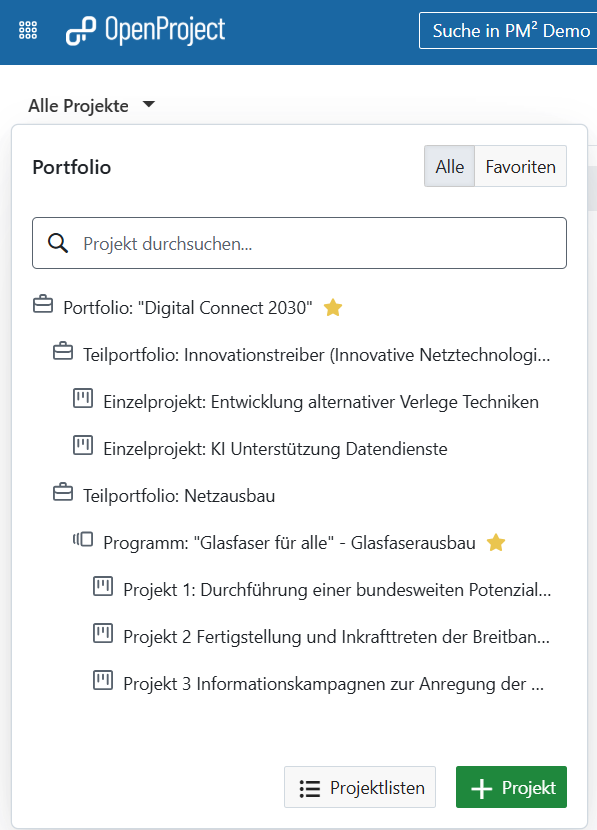
Mejora de los cuadros de mando de carteras y programas
En las páginas de resumen de carteras, (sub)programas o incluso proyectos, los gestores quieren ver de un vistazo información clave sobre objetivos, hitos, riesgos y presupuestos. Para ello, durante el hackatón creamos widgets que agregan visualmente estos datos: gráficos de presupuestos y riesgos, listados de componentes con su prioridad, estado y progreso de los objetivos. Estos widgets se implementaron como prototipos en un nuevo panel de control utilizando el Sistema de diseño OpenProject.
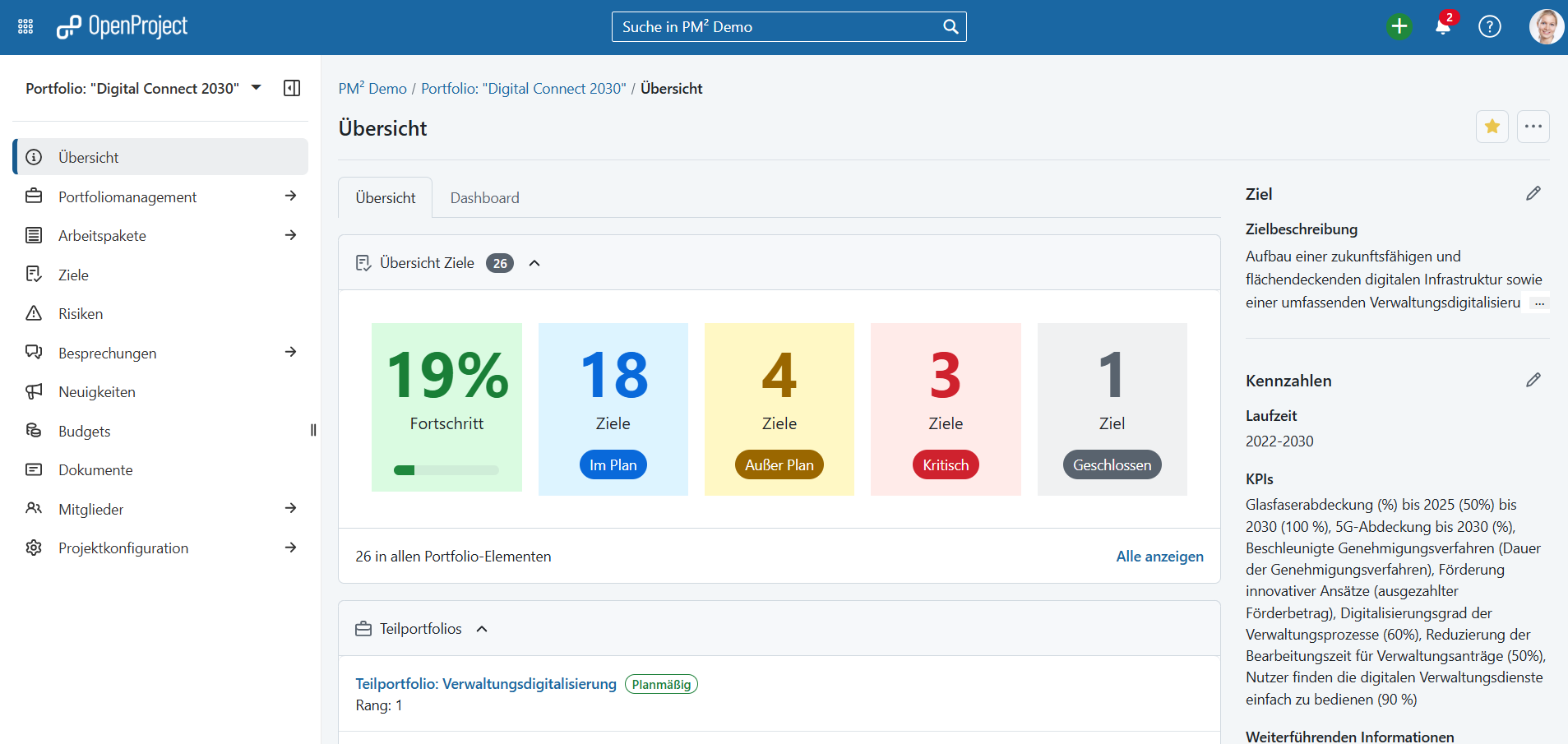
Gestión de cartera con funcionalidad de propuesta
Hemos creado un módulo específico para la gestión de carteras en el que los gestores pueden crear primero propuestas de carteras y enviarlas después para su revisión. Pueden descargarse en formato PDF o añadirse a una reunión.
Captura de pantalla: Módulo «Gestión de cartera» con una lista de propuestas que se puede guardar y filtrar, incluyendo atributos como el estado, el presupuesto y la calificación global. El menú desplegable del botón «Enviar para revisión» ofrece las opciones de descargar como PDF, añadir a la reunión o crear un documento de aprobación.](openproject-portfolio-vorschlag.png){: .image-screenshot }
Vinculación y mejora de la visualización de la planificación presupuestaria y las sinopsis
OpenProject ya admite un amplio seguimiento de presupuestos y costes, pero antes lo limitaba a proyectos individuales. Durante el hackatón, añadimos la presupuestación entre proyectos, la distinción entre costes previstos y contabilizados, y la modelización de subpresupuestos. La página de resumen y las listas de proyectos pueden mostrar ahora los presupuestos totales y sus componentes.
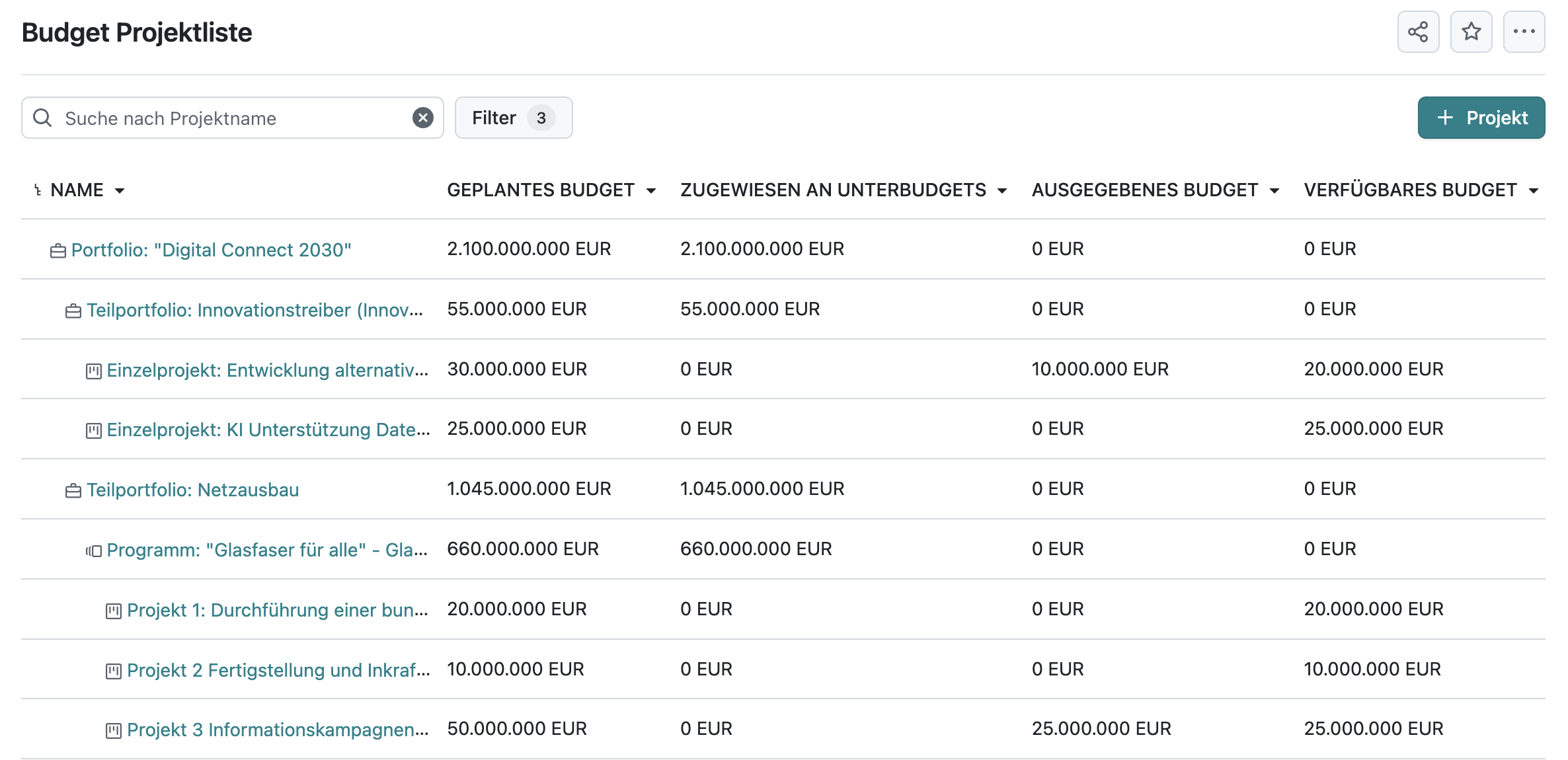
Puntuación calculada del proyecto
Los gestores de carteras desean calcular automáticamente las puntuaciones de los proyectos en función de sus atributos, lo que permite una mejor evaluación, priorización y comunicación de las decisiones. Esta funcionalidad se siguió desarrollando durante el hackatón y se activó en la instancia de demostración para mostrar los valores de clasificación para la ponderación de los proyectos.
Ahora es posible aplicar fórmulas a valores de libre configuración que, en conjunto, generan una puntuación. Esto aumenta la transparencia y la comparabilidad de las evaluaciones.
Esta función aún está en desarrollo (gracias ciudad de Colonia por su apoyo en este aspecto), por lo que aquí mostramos un borrador del diseño:
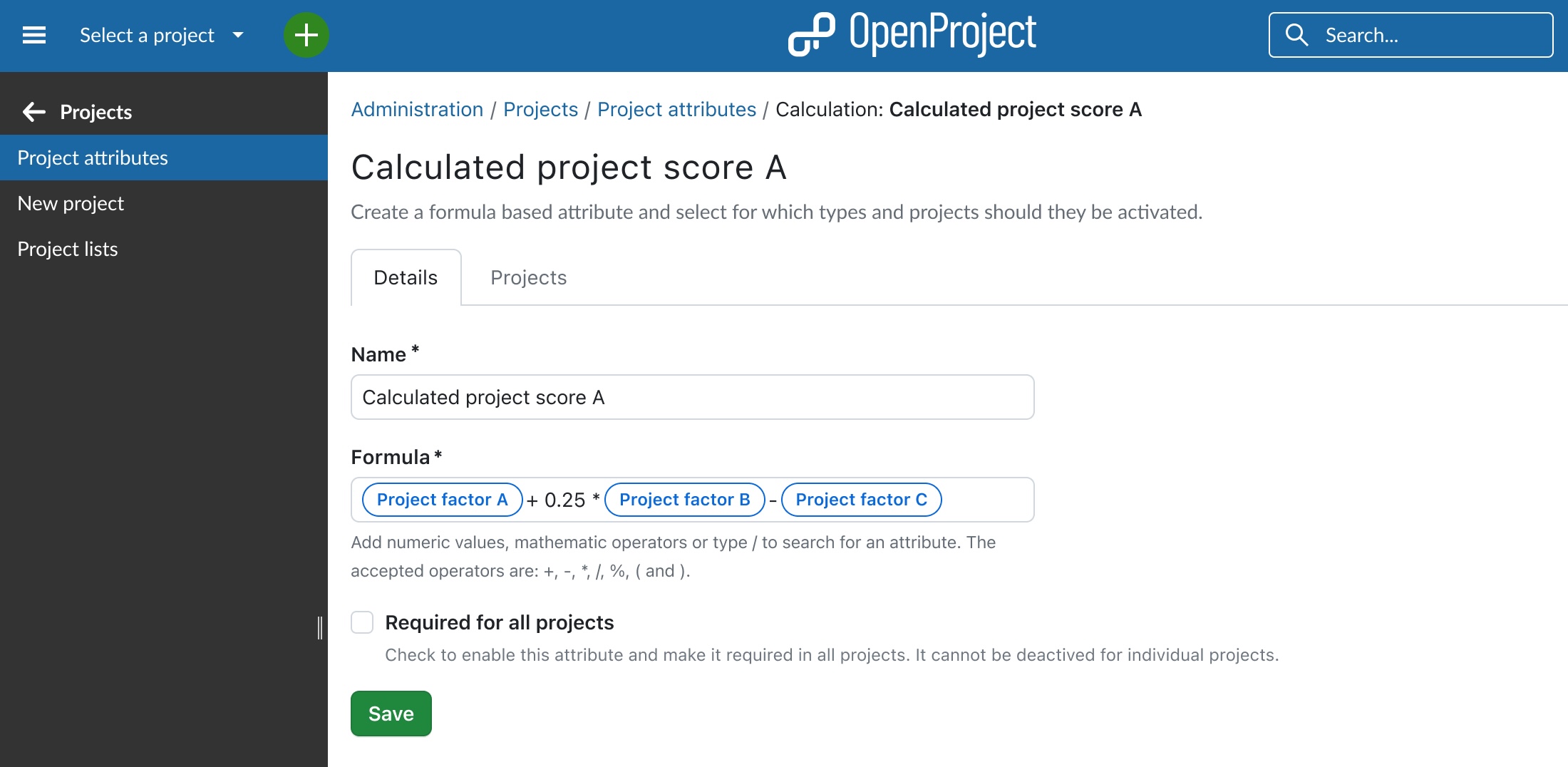
Gestión de riesgos y resumen
Dado que la gestión de riesgos es un requisito fundamental para el sector público, hemos creado un módulo dedicado a los riesgos. Incluye una matriz de riesgos que visualiza los riesgos del proyecto, la cartera o el programa con una gravedad codificada por colores.
La modelización se basa en la probabilidad (1-5) y el impacto (1-5). El sistema calcula un nivel de riesgo a partir de estos valores.
Esto también significa que los riesgos tienen ahora su propio tipo de datos y son una parte esencial de OpenProject. Se anima a los usuarios a documentar los riesgos, controlarlos regularmente y tomar contramedidas.

Creación de reuniones para informes de estado
Los informes de estado son un elemento clave de PM². Pero no son solo documentos: a menudo se debaten en las reuniones. Por eso hemos creado una función para generar automáticamente reuniones de informes de estado.
Directamente desde la página de resumen, los gestores pueden crear propuestas para una reunión de informe de estado con el comité directivo. Pueden seleccionar un marco temporal de referencia y añadir la información actualmente relevante de la cartera. El sistema genera una agenda basada en los cambios seleccionados para su posterior edición.
Captura de pantalla: panel de control de la cartera con modal para crear una reunión de informe de estado. Incluye el marco temporal de referencia (por ejemplo, el último mes) y conmutadores para cambios en la cartera, el presupuesto o los hitos](openproject-besprechung-statusbericht.png){: .image-screenshot }
Módulo de documentos con edición en tiempo real
Hace unas semanas, OpenProject participó con éxito en el evento Hack Days 2025 en París, organizado por la dirección digital del gobierno francés, DINUM (Dirección Interministerial de Digitalización). Ahora hemos ampliado esas funciones para permitir la edición colaborativa en tiempo real para varios usuarios.
Para apoyar la creación colaborativa y el intercambio de documentos típicos, se ha rediseñado por completo el módulo de documentos de OpenProject. Ahora permite la actualización automática de contenidos y la edición colaborativa en tiempo real.
Mejoras en la aplicación móvil para la gestión de carteras/programas
Llevamos algún tiempo trabajando en una aplicación móvil (iOS/Android) para OpenProject. Durante el hackatón, también desarrollamos una nueva funcionalidad para diferenciar entre los niveles de cartera, programa y proyecto en la aplicación.
Tenga en cuenta que el desarrollo de una aplicación móvil de alta calidad lleva tiempo y queremos garantizarle la mejor experiencia antes de su lanzamiento. Por supuesto, anunciaremos la disponibilidad tan pronto como esté lista para los usuarios.
Fundamentos y soporte de IA para documentos y gestión de proyectos/carteras
OpenProject se amplió con dos servicios centrales: Haystack para recopilar información relevante, y un LLM (Large Language Model) personalizado. Ambos servicios funcionan dentro de la misma red que OpenProject y no tienen acceso a Internet. Ningún dato sale del clúster para el uso de la IA.
Las funciones detalladas de la IA desarrolladas durante el hackatón incluyen:
Borradores de informes de estado generados por IA
- Cree borradores de informes de estado basados en paquetes de trabajo y atributos visibles para el usuario respectivo, utilizando una IA local entrenada en PMflex.
Asistencia de IA en la gestión de proyectos y carteras
- Visualización de las mejores prácticas basadas en PMflex en la página de resumen, a partir del análisis de los datos del proyecto y de los paquetes de trabajo
- Una IA local segura ayuda a introducir las mejores prácticas y proporciona recomendaciones de gestión oportunas
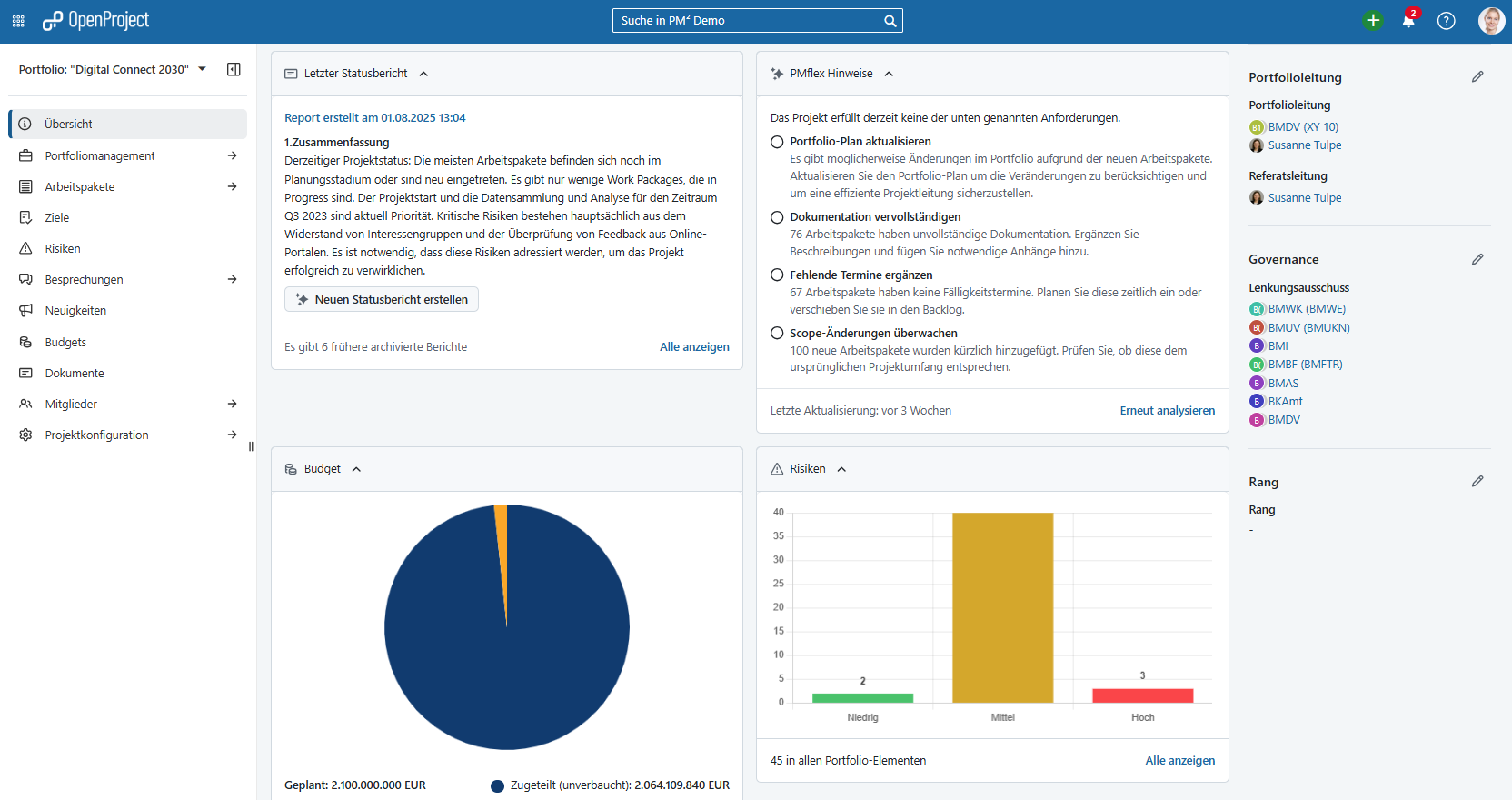
Apoyo de la IA en los documentos
- Herramientas de escritura en el editor de OpenProject (traducir, reformular, revisar la ortografía, generar borradores, etc.)
- Funciones familiares de edición de IA directamente dentro del editor
- El módulo de documentos utiliza el LLM para realizar tareas de texto sencillas como resúmenes

Exportación en PDF de la cartera y el estado del programa
Creemos en una única fuente de verdad para los datos del proyecto. Sin embargo, existen muchos casos de uso en los que una exportación resulta extremadamente útil, por ejemplo, cuando es necesario documentar información en sistemas externos. Así que durante el hackatón construimos un motor de informes de estado que crea archivos PDF perfectos a partir de los datos del sistema.
- Información de estado
- Presupuesto
- Riesgos
- Objetivos
- KPI
- Hitos
- Atributos personalizados
- […]
Felicitaciones al Ministerio Federal del Interior alemán que patrocinó la exportación en PDF de los paquetes de trabajo en 2023. La biblioteca de exportación a PDF que desarrollamos sentó las bases de esta función.
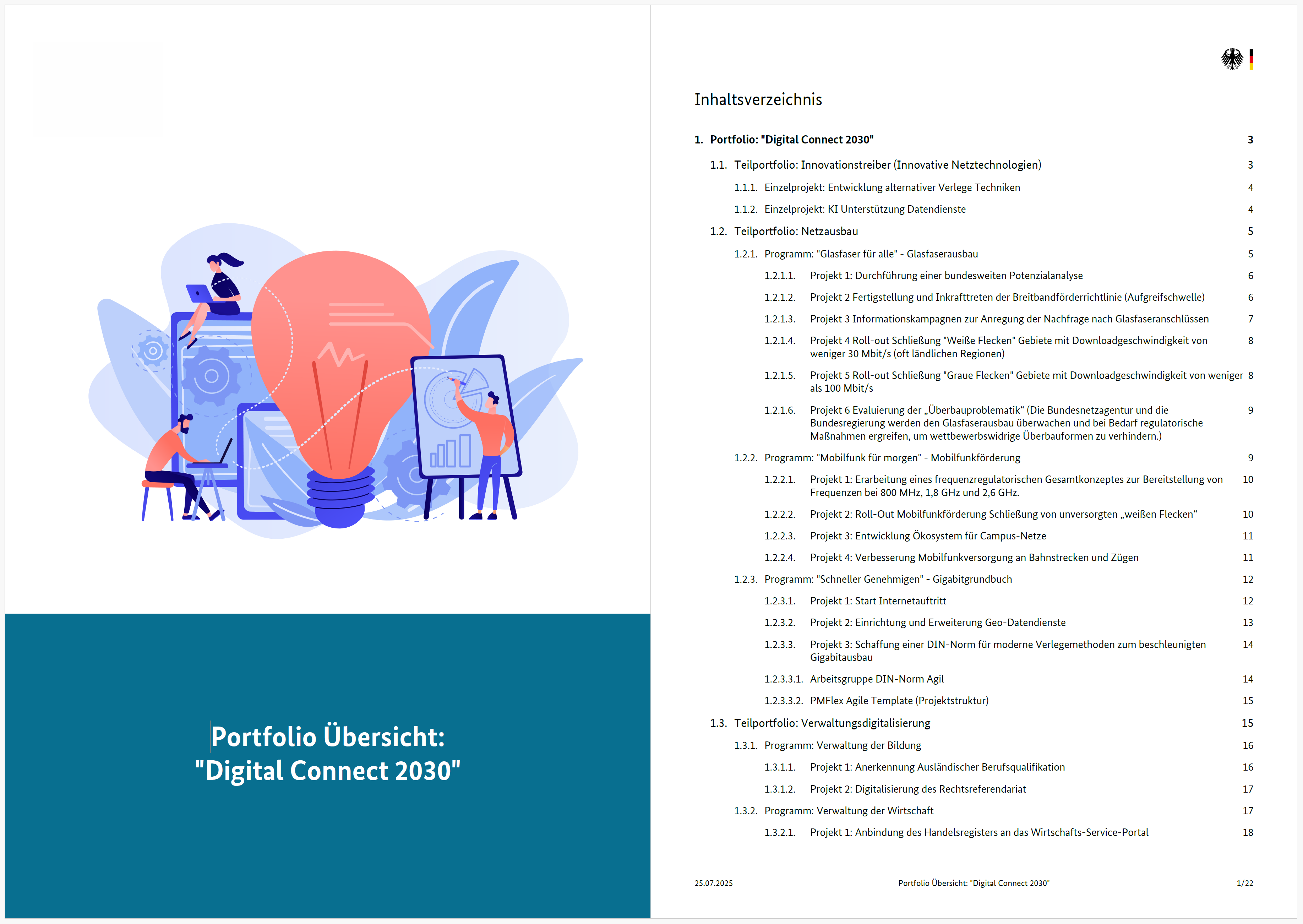
Como perspectiva, estamos trabajando en más opciones de configuración para ajustar la exportación a las necesidades específicas. Además, tenemos previsto añadir más gráficos e ilustraciones.
¿Ya lo encontró? ¿Qué ocurre después del hackatón?
Todas las funciones lanzadas estarán disponibles tanto en OpenProject como en openDesk, la suite segura de oficina y colaboración diseñada específicamente para el sector público.
El despliegue se realizaría probablemente del siguiente modo:
- Distribución a través de ZenDiS como módulo en openDesk:
- Publicaciones mensuales
- Conceptos de seguridad
- Mantenimiento
- Soporte
- Alojamiento
- Entornos de demostración proporcionados a través de la infraestructura SaaS de OpenProject
Aunque el trabajo está en curso, este hackatón demostró claramente cómo OpenProject, como solución de código abierto, puede satisfacer los requisitos concretos de la administración pública, de forma rápida, competente y colaborativa.
Se observa un cambio evidente hacia la soberanía de los datos, los estándares abiertos y las soluciones de software independientes, no solo, aunque especialmente, en el sector público.
Cualquiera que busque una solución soberana y preparada para el futuro encontrará en OpenProject un socio fuerte y experimentado. Más información sobre OpenProject para la administración pública.




